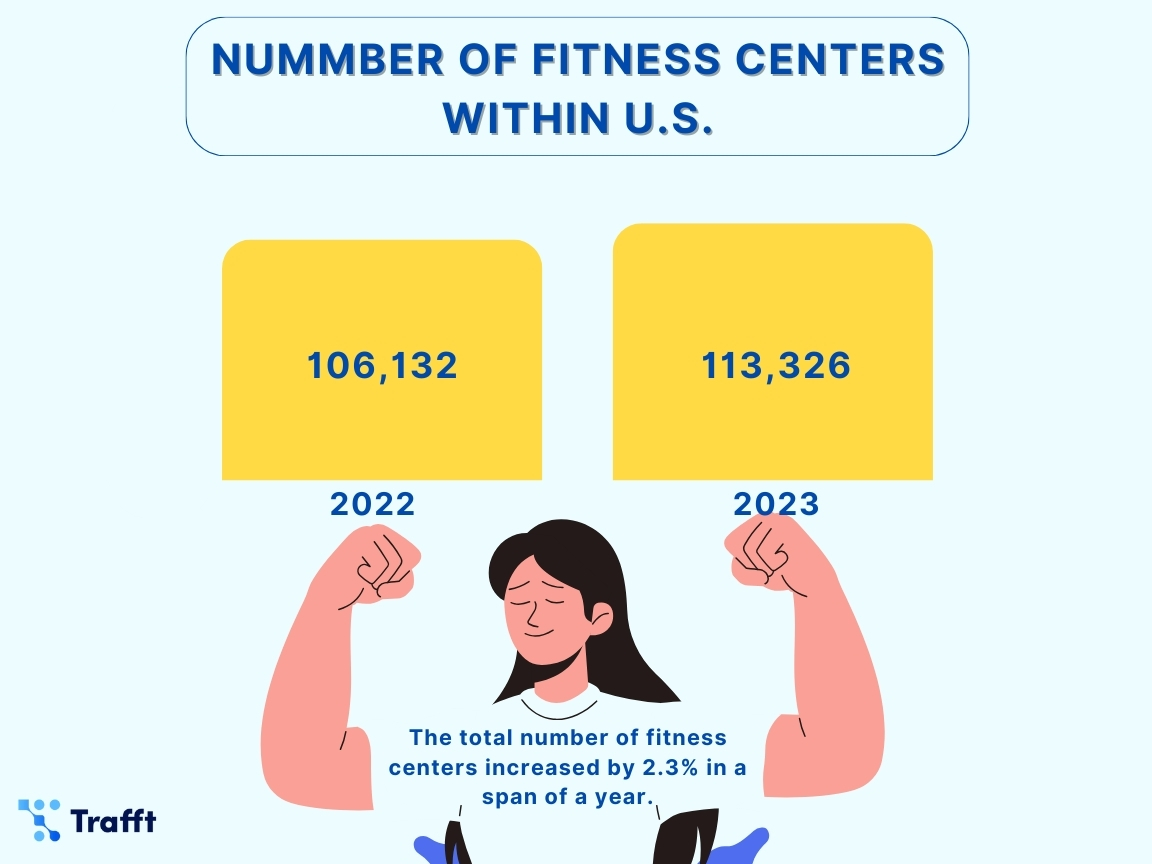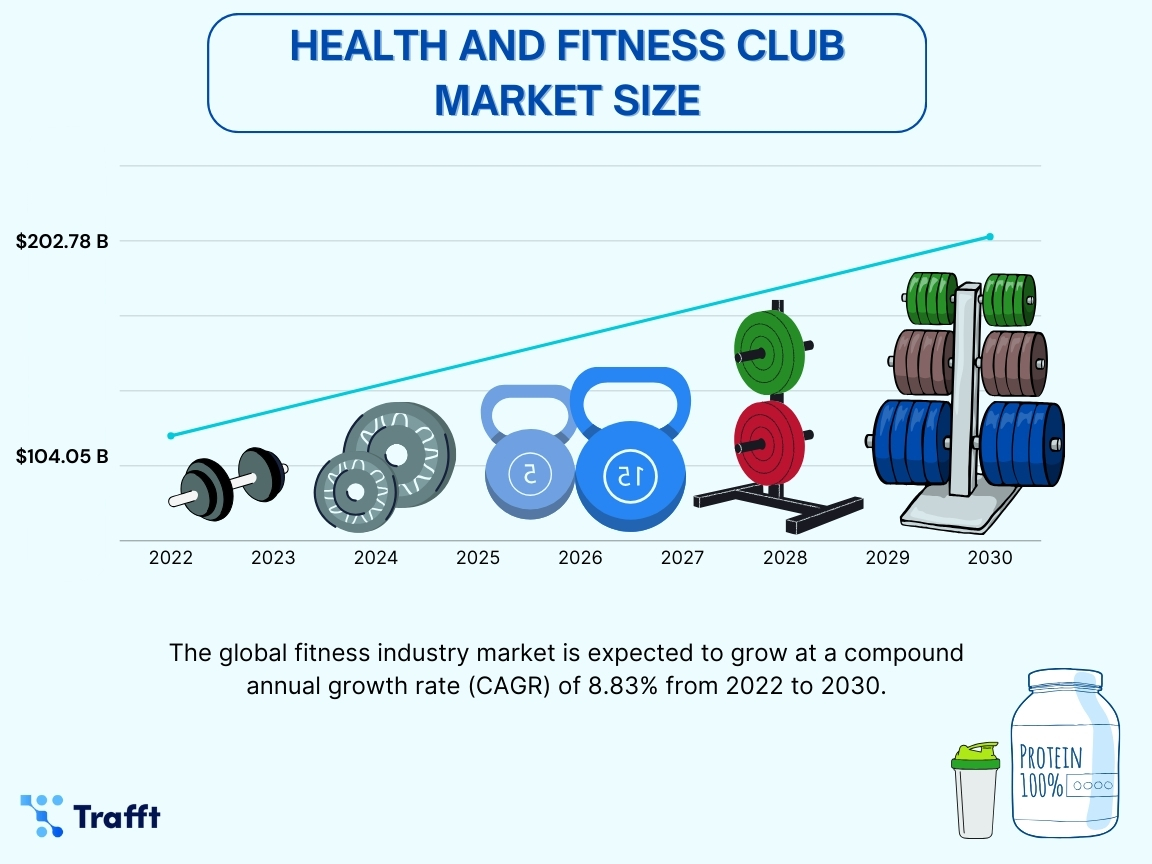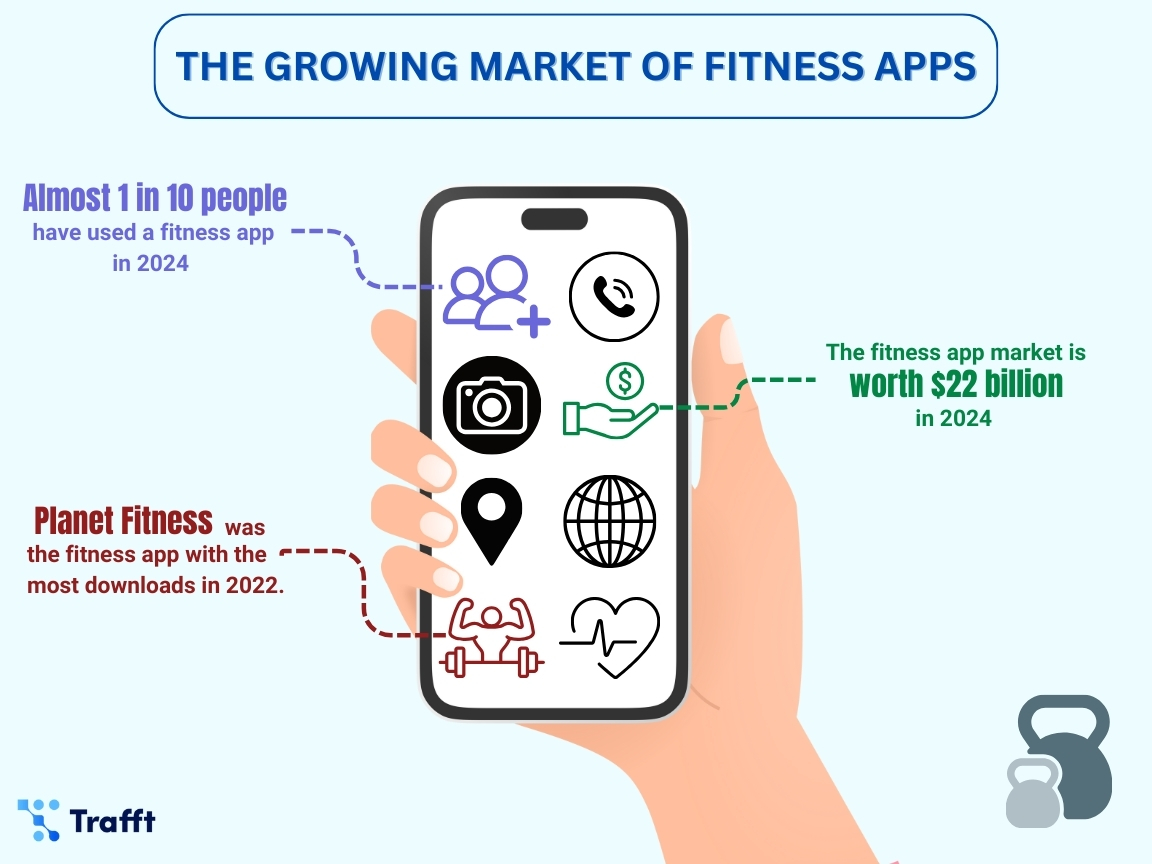You may have heard that after the pandemic, more and more people are becoming interested in fitness, either as a personal trainer, gym owner, or just as a hobby. No matter the category you fall in, being familiar with fitness industry statistics can offer you some much-needed insights. Understanding trends and data points can help you make informed decisions and develop strategies to thrive in the evolving fitness landscape.
But how many people work out? What are some growth trends? And is it worth it to venture out into this field? To answer this and many more questions you may have, we will look over some key statistics.
Growing Population of Fitness Clubs
So, how many fitness clubs are there in the USA? As people are becoming more aware of proper exercise, the number of gym goers increases every year. The same trend can be observed when it comes to fitness clubs. The number of gyms in the U.S. in 2022 was 106,132. In the past year, there was a 2.3% increase in the total number of fitness centers; now, the number stands at 113,326 as of 2023.

When we look at projections for the future, it is estimated that the number will reach new highs. For example, the global pilates & yoga studios market is expected to grow at a CAGR of 10% from 2021 to 2028. This is undeniably due to the increasing population of this type of exercise and more and more clubs being open.
Overlook of the Market Size and Future Fitness Industry Trends
The global fitness industry market size was valued at $104.05 billion in 2022 and is projected to grow to about $202.78 billion by 2030. So, there is an 8.83% CAGR during the forecast period. North America dominated the health and fitness club market with a market share of 42.59% in 2022. This comes as no surprise when you account for weight-related health problems like obesity and diabetes.

For instance, according to the U.S. Centers for Disease Control and Prevention (CDC), there are currently 38.4 million individuals diagnosed with diabetes in the U.S. alone (11.6% of their population). When you add to this amount the number of people diagnosed with prediabetes as well, there is a good chance the fitness market will keep growing for decades to come.
Future fitness industry trends include a rise in remote fitness sessions, virtual training platforms, fitness apps, and home workout equipment purchases. These growing trends reflect an even higher demand for flexible and convenient alternatives to traditional gym settings.
Switch to the Online Realm
In 2020, everything shut down, and as a result, the fitness industry's revenue declined by 32.45%. However, one particular kind of fitness saw a great increase, and that's online fitness. When you put things into perspective, this makes perfect sense, as the pandemic only heightened the importance of health and proper workout routines. Prior to the pandemic, the online fitness market was valued at $6bn.
But people liked the convenience as the world opened up; many stuck to their fitness apps, some even as an addition to a traditional gym membership. The online market is predicted to grow at 32.7% CAGR, which means it will be worth $250,7 bn by 2032.
Interestingly enough, online exercise classes were the #9 fitness trend for 2022 but dropped out of the top 10 in 2023.
However, the online workout industry faces challenges similar to those faced by traditional gyms, particularly in terms of client retention.
The Rise of Fitness Apps
There is an app for everything these days and with good reason. People love convenience, and apps offer just that. Fitness apps are often the missing link between traditional fitness methods and modern lifestyles, offering users flexibility, accessibility, and personalized workout routines.
For those looking to tap into this booming industry, understanding how to make a fitness app provides the foundation for developing solutions that not only meet user expectations but also stand out in a competitive market.
When we look at the age groups, millennials use fitness apps more than any other group, with women using them twice as much as men. Overall, 41% of those aged 30 to 39 people have used fitness-tracking apps to monitor their health.
Here is some other interesting data involving fitness apps:
- Almost 1 in 10 people (9.76%) use a fitness app in 2024, and this is expected to reach 12.2% by 2027. (Statista)
- The fitness app market is worth $22bn in 2024 and growing at a rate of 14.3%. (Mordor Intelligence)
- As of 2022, the fitness app with the most downloads is Planet Fitness. (Mordor Intelligence)

Biggest trend of 2024: Wearable technology
With fitness apps taking over, the need for something that will accurately track our workout has never been more pronounced. Wearable technology has emerged as the solution to the newfound problem. It offers real-time heart rate data, the number of calories burned, steps taken, sleep duration, and more. They connect to the smartphone, and we get all the data nicely categorized and easily digestible.
Wearable technology has been in the top three trends since 2016 and is now peaking at number one. Many fitness trainers use these metrics when working with clients, especially if they specialize in online coaching.
The global wearable technology market size was valued at USD 71.9 billion in 2023 and is expected to expand at a compound annual growth rate (CAGR) of 14.6% until 2030. Major companies like Samsung, Apple, Fitbit, and Nike have recognized the potential in this market and are all competing for the top spot.
As for the regional insights, North America dominated the global industry in 2022 and accounted for a maximum share of 33.80 % of the overall revenue, followed by Asia Pacific and Europe.
Gym Membership Statistics and Other Health and Wellness Trends
Many people's first association with the growing fitness industry is the increasing number of gyms and gym goers. While we covered the number of clubs around the U.S., now we should take a brief overview of the clientele.
So, how many people go to the gym? According to the 2020 IHRSA report, there were about 184.59 million worldwide memberships, which accounts for 2.4% of the world's population. January is the peak month for joining a gym, and more than half of the gym members are female.
As for other health and wellness institutions, the boutique fitness industry is expected to have a market size of 51.6 billion dollars in 2024. When we look at the costs, the average price of a boutique fitness studio membership is around $90. Participants average around 30 years of age and are more likely to participate in more than one health club.
Similar to growing exercise recognition, more and more people are investing in their overall well-being. In 2022, the global wellness economy reached $5.6 trillion, nearly 14% higher than its size in 2019. The projection is that the industry will maintain an 8.6% average annual growth rate, with the wellness economy reaching $8.5 trillion in 2027.
Wellness apps also have a high number of downloads, with the biggest user base choosing Calm (8.8 million downloads nationwide).
Additional Interesting Statistics on the Fitness Industry
- According to Statista, the most popular sports activity in the U.S. as of March 2024 is Hiking, and the least popular are Winter sports.
- The popularity of on-demand video fitness classes grew by 311% post-COVID.
- In the study done by MindBody, 74% of people said they prefer to work out under the expert guidance of an instructor.
- Wellness is a top priority for nearly 40% of people worldwide.
- In 2022, there were over 181,000 spas, earning $105 billion in revenues.
- Mindful movement has been the fastest-growing segment of physical activity both before and after the pandemic (16.8% increase from 2019-2022), as millions turned to yoga for at-home exercise and stress reduction.
- At-home fitness equipment market size is anticipated to grow from $8.07 billion in 2022 to $17.91 billion in the next ten years.
Let’s Recap
When we look at people around us and our own increasing interest in fitness and a healthier lifestyle, it’s no surprise that the fitness industry is worth over $90 billion. But in order to help you better grasp the size of this market, we laid out all the fitness industry stats you may find relevant or interesting.
If you plan on starting your own business either as a personal trainer or a gym owner, we are sure you will find these gym statistics relevant. After all, they should provide you with valuable insights into consumer behavior, market trends, and the competitive landscape. Use all the data to develop effective strategies and capitalize on the right opportunities.
Lastly, to help you further in your career building, we prepared guides on how to become a personal trainer and how to create a gym business plan. We also wrote about gym membership statistics, which you may also find relevant.






